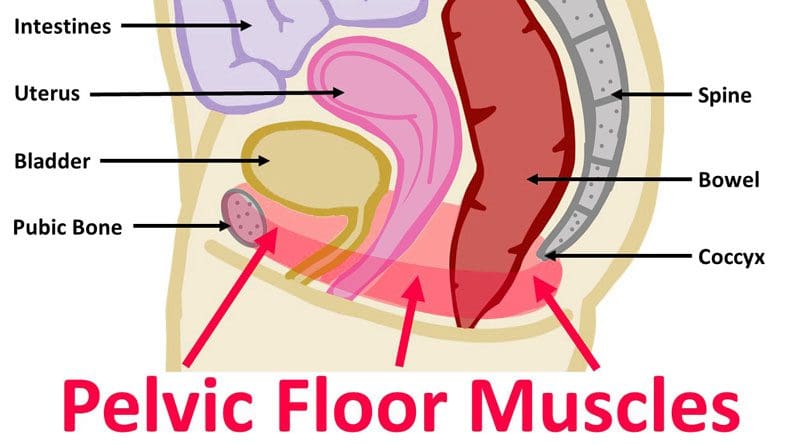The pelvic floor is essentially the spine, and when pain presents, it can be mistaken for back pain. However, these two conditions are frequently linked. The National Institutes of Health- NIH reported that a quarter of women are impacted by pelvic floor disorders and up to 16% of men. The pelvic floor is made up of muscles. If the muscles begin to spasm, they can spread pain upwards and even downwards. This is where the misdiagnosis of lower back pain comes in.

The Pelvic Floor
The pelvic floor is comprised of muscles and connective tissue, known as fascia. The muscles and fascia intertwine, creating a support system for the pelvic organs. The pelvic floor muscles act as a spring system that supports the organs. When downward pressure is applied, and the spring system is working correctly, they push back up to support the muscles. These muscles create the base known as the core. The core muscles support the abdomen, diaphragm, and back muscles, supporting the spine. This is why back, pelvic pain is prevalent as these muscles are interconnected.
Pelvic Floor Dysfunction and Back Pain
If there is pelvic floor dysfunction, there is an inability to control the muscles. There can be too much or insufficient tension, resulting in urinary incontinence or inability to complete bowel movements. It can also be mistaken for back pain or contributes to pelvic and low back pain. The core muscles support the torso and promote stabilization during movement. If they are not working correctly, the torso and pelvis become unstable. The SI - sacroiliac joints linked with the pelvis and the lower spine can begin to present with posterior pelvic and back pain.
Symptoms
Dysfunction can present in several ways, including:
- Constipation
- Incomplete bowel movements
- Urine leakage
- Fecal leaking
- Painful sex for women
- Erectile dysfunction in men
Causes of Dysfunction
Causes of dysfunction include:
- Weakness of the muscles or tight muscles.
- Vaginal dryness by a lack of estrogen during menopause.
- Tight inner thigh muscles.
- Back pain itself can cause dysfunction.
Women make up the majority of cases that result from:
- Pregnancy
- Childbirth
- Endometriosis - a condition in which uterine tissue grows outside the uterus.
Men can also develop problems. As a man's body ages, prostate problems can cause urinary leakage and frequency problems. It can develop from activities like bicycling. The seat can compress the pudendal nerve, causing pain and dysfunction.
Retraining the Muscles
The dysfunction can be helped by reactivating and strengthening the pelvic and core muscles. Training the pelvic floor and the core muscles will help boost support for the spine and alleviate discomfort and pain. First, it is recommended to get a physical evaluation by a chiropractor or physical therapist to determine if the pelvic floor muscles are too tight or weak. The objective is to improve the strength of the pelvic floor muscles or relax them if they are too tight. A chiropractor and physical therapist can work on the muscles, educate on stretches, exercises, nutrition, and offer additional help and support.
Body Composition
Muscle Adaptation
The point of resistance training is to get the muscles to function more effectively. It begins with the contractile proteins that control muscle shortening and lengthening. Resistance exercise can cause some of the proteins to get pulled apart. The stress the muscles experience is the stimulus for the muscles to rebuild bigger, stronger, or more powerful. After resistance exercise, the muscle synthesizes proteins helped by nutritional stimuli and protein consumption. Satellite cells also activate to help build up the broken-down muscle. Resistance exercise causes activation.
The information herein is not intended to replace a
one-on-one relationship with a qualified health care professional, licensed
physician, and is not medical advice. We encourage you to make your own health
care decisions based on your research and partnership with a qualified health
care professional. Our information scope is limited to
chiropractic, musculoskeletal, physical medicines, wellness, sensitive health
issues, functional medicine articles, topics, and discussions. We provide and
present clinical collaboration with specialists from a wide array of
disciplines. Each specialist is governed by their professional scope of
practice and their jurisdiction of licensure. We use functional health &
wellness protocols to treat and support care for the injuries or disorders of
the musculoskeletal system. Our videos, posts, topics, subjects, and insights
cover clinical matters, issues, and topics that relate to and support, directly
or indirectly, our clinical scope of practice.* Our office has made a reasonable
attempt to provide supportive citations and has identified the relevant
research study or studies supporting our posts. We
provide copies of supporting research studies available to regulatory boards
and the public upon request.
We understand that we cover matters that require an
additional explanation of how it may assist in a particular care plan or
treatment protocol; therefore, to further discuss the subject matter above,
please feel free to ask Dr. Alex
Jimenez or contact us at 915-850-0900.
Dr.
Alex Jimenez DC, MSACP, CCST, IFMCP*, CIFM*, ATN*
email: coach@elpasofunctionalmedicine.com
Licensed in: Texas & New Mexico*
References
Cleveland Clinic. (2020). "Pelvic Floor Dysfunction." https://my.clevelandclinic.org/health/diseases/14459-pelvic-floor-dysfunction
National Institutes of Health. (September 2008) "Roughly One-Quarter of U.S. Women Affected by Pelvic Floor Disorders" https://www.nih.gov/news-events/news-releases/roughly-one-quarter-us-women-affected-pelvic-floor-disorders
Smith, Christopher P. "Male chronic pelvic pain: An update." Indian journal of urology: IJU: journal of the Urological Society of India vol. 32,1 (2016): 34-9. doi:10.4103/0970-1591.173105
World Health Organization. (2013) "Low back pain" https://www.who.int/medicines/areas/priority_medicines/Ch6_24LBP.pdf




